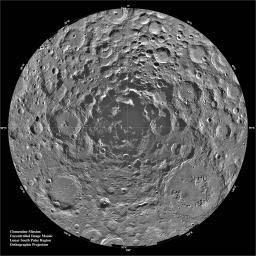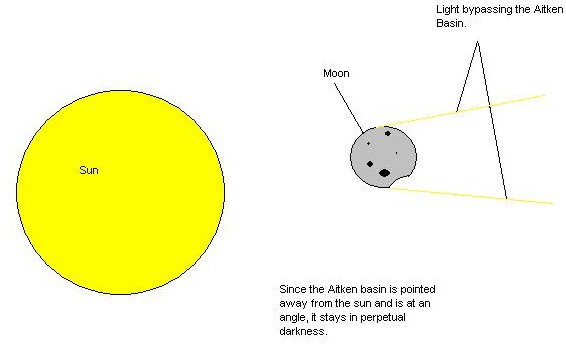|
Purpose: This page will describe the Aitken basin to the reader and why we would want to start our search for lunar water in this area.
 |
The Aitken Basin, known also as the South Pole of the moon, is a large crater on the southern hemisphere of the moon. It is, on average, 10 kilometers deep, and is about 2500 kilometers at its widest point[6]. It is considered the largest known impact crater in the solar system.
The Aitken Basin is richer in ferrous oxide (rust) and titanium dioxide than the rest of the moon, which makes it look darker[6]. Also, there is very little mantle in the crater, which means the entire upper layer of the geosphere was blown into space during a colossal meteor or comet impact[6].
|
The existence of the crater was suspected as early as 1962, but it wasn't until the Lunar Orbiter Program in the mid-60s that confirmed its existence[17]. Still, very little was known until the Galileo and Clementine spacecraft examined it in the 1990s. Explanations for the large concentrations of rust and titanium oxide range from pools of iron-rich basalt to exposed rocks from underneath the moon's surface[6].
Because of the depth of the crater and the height of the crater walls, 15,000 square km of the south pole/Aitken basin region (SPA) never see sunlight, and can get down to a constant -220 to -230 degrees Celsius (40-50 degrees Kelvin) [1]. Most of these craters in the SPA region have been there for 3-4 billion years. Because of the extreme cold many scientist believe that this area is cold and deep enough to house water brought to the moon by cometary impacts[1]. The image below shows why this area does not get any sunlight. Please note this drawing is not to scale.

Past robotic satellites have detected large amounts of extremely cold pockets of water ice. The Clementine mission mapped the moon from February through May 1994 [10]. The Clementine mission to the moon studied the lunar south pole region extensively and determined through radar data that water ice does indeed reside at the bottom of the Aitken basin.
In order to detect water, the Clementine spacecraft bounced radar waves off of the lunar surface. The rocky lunar surface will tend to scatter radio waves while the smooth and shiny ice will tend to act like a reflector bouncing the radar waves back to the spacecraft in a coherent manner[6]. The spacecraft measured the strength of the returning radar data and, on orbit 235, passed directly over the south pole and received a radar echo characteristic of water ice[10]. No where else on the moon did the space craft receive these characteristic radar echoes. Initial estimates place the volume of water at around 1 billion cubic meters of water [10]. |
